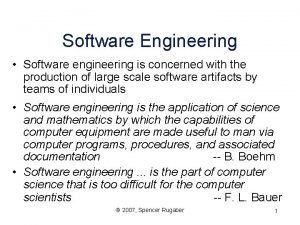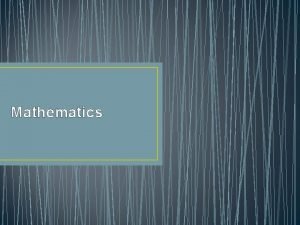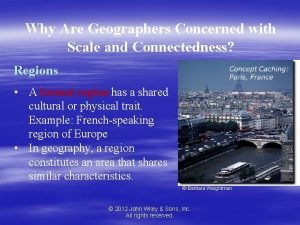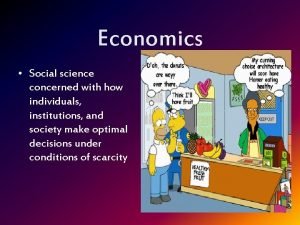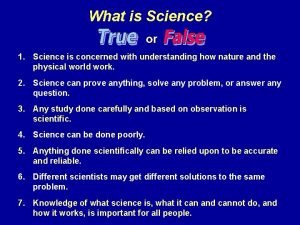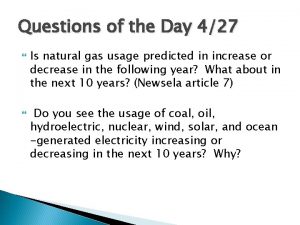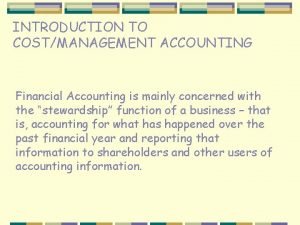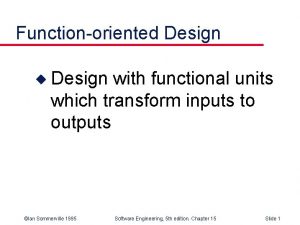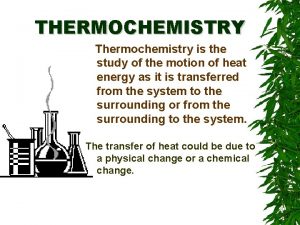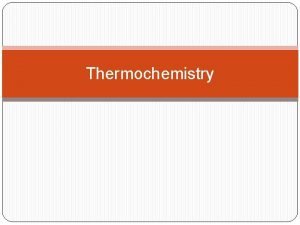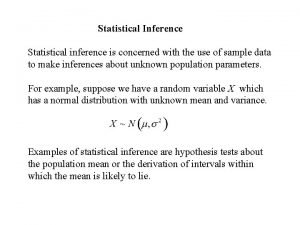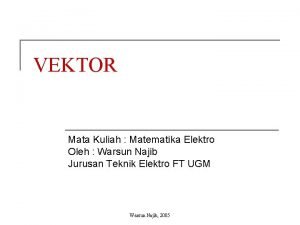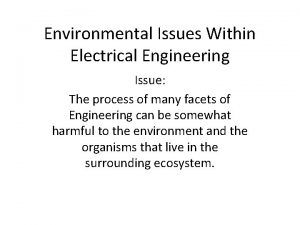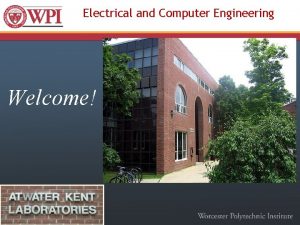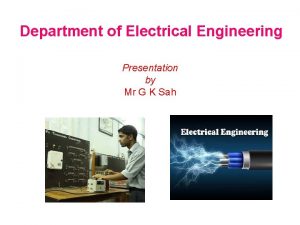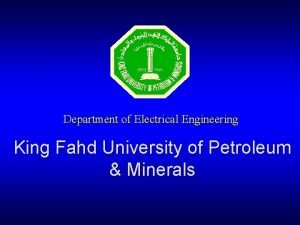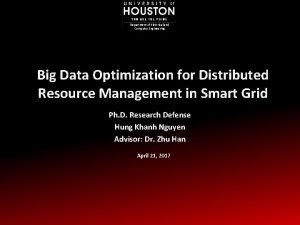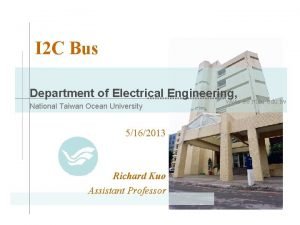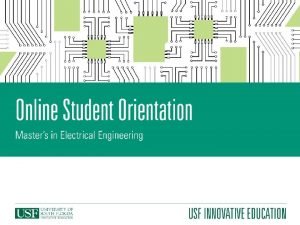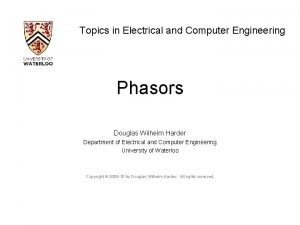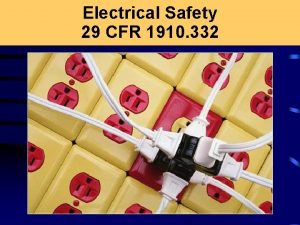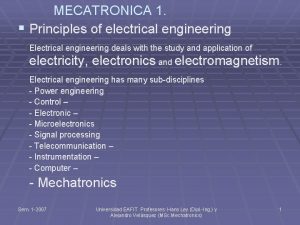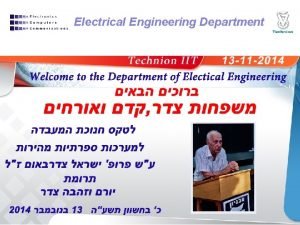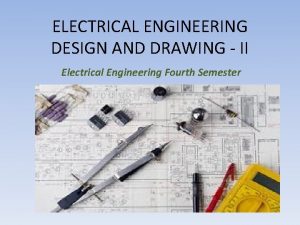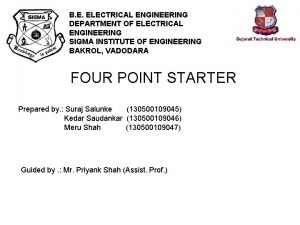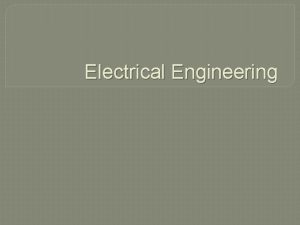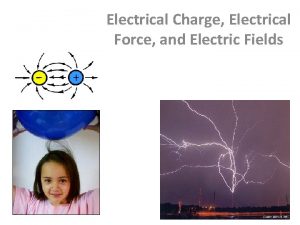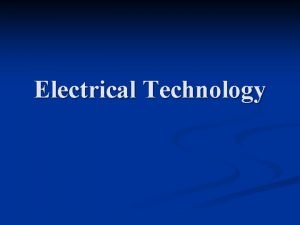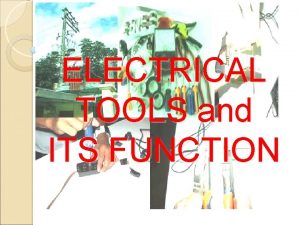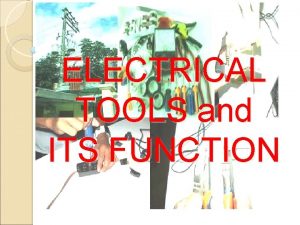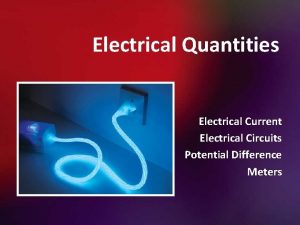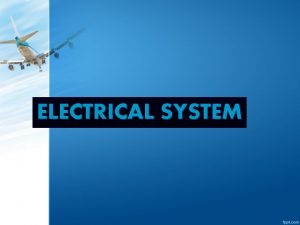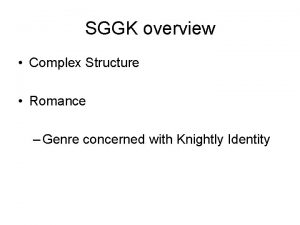OVERVIEW OF ELECTRICAL ENGINEERING Electrical engineering is concerned





















































- Slides: 53

OVERVIEW OF ELECTRICAL ENGINEERING

�Electrical engineering is concerned with the basic forms of energy that run our world. �Gas �Hydro �Turbine �Fuel cell �Geothermal �Wind �Photovoltaics �Electrical Engineers deal with the distribution of these energies from their sources to our daily usage. (Homes, Factories, Offices, Hospitals, Schools, …etc…. )

SCOPE FOR ELECTRICAL ENGINEERs

�Government sector and Private companies �Defense , Space and Research organizations �Installation and Maintenance

�Industries involved in �Design and fabrication of devices �Integrated circuits �Embedded systems �Electronic equipments etc have also provided large scale placements for engineers with this specialization.

�Knowledge of � Computer Hardware � Networking equipments � Communication systems � Enables Electrical Engineering graduates help them to annex an edge in the IT job market �The skills and understanding developed in the course enable them to be preferred, as software professionals by IT companies.

IMPACT OF ELECTRICAL ENGINEERING ON NATIONAL ECONOMY

Ø Electrical engineering industry encompasses a wide area of activities from Ø lighting to mobile communications and Ø that is why this industry has a huge capital earning potentiality, which can strengthen the economy of a country. Ø Electrical engineering industry can reduce the growing world economies from the vulnerability to energy shortages.

Ø Clean electrical energy can be an alternative source of power. Ø But we normally acquire from hydrocarbons like Ø Coal and Ø Petroleum products etc. . and this way it is gradually leading to Global Warming, in turn affecting everything around us.

ENERGY CONSUMPTION

Energy Supply Systems Urban (Industrial & Commercial Activities) Rural (Household levels) v Important for country’s economic development v Bulk of the energy is consumed at the household v Largest share of commercial energy consumption (hydro-, thermo-, nuclear-power, or from coal and petroleum products). v Woodfuel, forms of biomass, biogas, micro-hydro, solar and wind power, mostly at a small scale. v Household energy consumption Insignificant compared to Industrial & Commercial Sectors. v Energy is primarily used for cooking food

Where does Electricity come from?

Energy consumption per capita in k. Wh India Italy Russia United Kingdom Germany France Japan Australia USA Canada 631 5644 5642 6206 7030 7689 8076 11126 13338 171 79

POWER CONSUMPTION FOR HOUSEHOLD

NEED OF THE HOUR �Renewable Sources of Energy or �Non-Conventional Sources of Energy

IMPACT OF ELECTRICAL ENGINEERING ON SUSTAINABILITY

ü Renewable energy technologies are essential contributors to sustainable energy they contribute ü To world energy security ü Reducing dependence on fossil fuel resources ü Providing opportunities for mitigating greenhouse gases. ü Conceptually, one can define three generations of renewable technologies, reaching back more than 100 years. ü First-generation technologies emerged from the revolution at the end of the 19 th century that includes ü ü Hydropower Biomass combustion Geothermal power Heat ü Some of these technologies are still in widespread use. industrial

SOLAR ENERGY

Ø Solar heating systems are a well known second-generation technology. Ø Generally consisting of solar thermal collectors, a fluid system to move the heat from the collector to its point of usage and a reservoir or tank for heat storage and subsequent use. Ø The systems may be used to heat Ø domestic hot water Ø swimming pool water, or Ø for space heating.

Ø In the 1980 s and early 1990 s, Ø most photovoltaic modules provided remote-area power supply, Ø But, from around 1995, industry efforts have focused increasingly on developing building Ø integrated photovoltaics and Ø power plants for grid connected applications.

Photovoltaic Systems***

Physics of Photovoltaic Generation n-type semiconductor + + + + - - - - - Depletion Zone p-type semiconductor

Indian PV Era — Vision 2020 Arid regions receive plentiful Solar radiation, regions like Rajasthan, Gujarat and Haryana receive sunlight in plenty. Thus the Potential availability - 20 MW/km 2 (source IREDA) IREDA is planning to electrify 18, 000 villages by year 2012 mainly through Solar PV systems Targets have been set for the large scale utilization of PV technology by different sectors within the next five years

WIND ENERGY

Wind - electricity production Insurance Against Conventional Fossil-based Price Risk No Greenhouse Gas Emissions No Sulfur Dioxide (SO 2), Nitrous Oxide (NOx), or Mercury Emissions

Why Wind Energy? Wind, for now, is the renewable energy resource/technology of choice “Free” resource A “clean” resource due to: Ø Replacement of a “dirty” energy source (coal) and, Ø No emissions associated with its use Can be utilized on underutilized land or on lands currently in commodity crop production (“harvest” on the surface and “harvest” above the surface) Will primarily be used for electricity generation for immediate end-use or as a “driver” for hydrogen production

Wind Energy Benefits No air emissions No fuel to mine, transport, or store No cooling water No water pollution No wastes

Wind Turbines

Turbines: Different Sizes and Applications Small ( 10 k. W) Intermediate • Homes (Gridconnected) • Farms • Remote Applications (10 -500 k. W) (e. g. battery changing, water pumping, telecom sites) • Village Power • Hybrid Systems • Distributed Power Large (500 k. W – 5 MW) • Central Station Wind Farms • Distributed Power • Offshore Wind

Large Wind Systems Ø Range in size from 100 k. W to 5 MW Ø Provide power Ø Require wholesale bulk 13 -mph average wind sites

Next Generation Wind Turbines

Wind Turbine Schematic

TYPES OF WIND TURBINES

Vertical wind speed variation �Wind speed increases as we go up, �increases rapidly at lower heights �but less rapidly at higher heights. �At about 2000 metres from the ground, the change in the wind speed becomes zero. �This variation of wind speed with height depends upon �terrain roughness and �wind speed near the ground.

Power in the wind �Kinetic energy in the wind owing across a wind turbine is used to derive electrical energy from the wind. �The Power in the wind turbine “P” is given by P= (1/2)ρAV 3 Where “ρ”=air density and at standard temperature (25⁰C) and pressure, is about 1. 22 kg/ m 3 “V” =wind velocity in m/s. “A”=Swept area.

ENERGY SAVING TIPS �Turn off the Electrical equipments when not in use. �Take advantage of daylight by using �light-colored loose-weave curtains on your windows to allow daylight to penetrate the room. �Also, decorate with lighter colors that reflect daylight. �De-dust lighting fixtures to maintain illumination.

�Compact fluorescent bulbs are four times more energy efficient than incandescent bulbs which provides the same lighting. �Do not switch on the power when TV and Audio Systems are not in use. idle operation leads to an energy loss of 10 watts/device. �If your computer must be left on, �turn off the monitor; �this device alone uses more than half the system's energy.

�Battery chargers, such as those for �laptops, �cell phones and �digital cameras, draw power whenever they are plugged in and are very inefficient. �Pull the plug and save. �Screen savers save computer screens, not energy. �Start-ups and shutdowns do not use any extra energy, nor are they hard on your computer components. �In fact, shutting computers down when you are finished using them actually reduces system wear – and saves energy

�In washing machines use timer facility to save energy. �Plant trees or shrubs to shade �air-conditioning units but not to block the airflow. �A unit operating in the shade uses as much as 10% less electricity than the same one operating in the sun


Electrical Hazards Ø Shocks Ø Electric Shock causes an involuntary grip which prolongs the period of contact Ø More the period of contact, more the damage Ø Passage of current through the heart, Ø stops the blood supply to the brain, Ø resulting in loss of consciousness and Ø termination of breathing

ØWhen a person standing at a height receives an electrical shock, it is most likely that he will fall. ØPersonal sensitivity to electrical shock varies from person to person

ØBurns Ø Whenever an electrical flash appears, and if a part of a body comes within flashing distance, burns can be caused. Ø Burns may be caused by short circuits as well, because a short circuit could create an electrical fire`

Preventive Measures �Allow only a qualified person to attend to your electrical repairs �Service your electrical equipment at frequent intervals through a competent electrician �In case of a short circuit or a fire, �Switch off the mains instantly �Make sure that you have easy access to switch off the supply source quickly, in case of an emergency �Make sure your extension cords are free from cuts, improper insulation, or joints.


�Ensure pins of your plugs are tight and not loose �Use switches of the correct current rating and preferably with indicators to indicate whether the switch is ON/OFF. �Use appliances with 3 pin plugs and connect them to 3 pin sockets �Do not overload electrical outlets or use extension cords in place of additional outlets �Provide proper earthing for the building/house

IMPACT OF ELECTRICAL ENGINEERING OVER ENVIRONMENT

Ø Large power sources can affect their surroundings through impacts such as Ø air pollution, Ø submergence of land Ø waste accumulation, Ø excessive resource use and Ø disruption of human activity. Ø Most of the existing thermal power plants in Ø China and India use the traditional pulverized coal combustion technology. Ø As a result, they have to contend with gaseous emissions including Ø Carbon dioxide (CO 2), carbon monoxide (CO) etc. , (Green house gases)

Ø When based on locally mined coal, Øthe associated problems of mining accidents and Øland degradation are serious. Ø Although based on a clean and renewable source, Ølarge hydroelectric plants are not impact-free. ØLarge dams can cause submergence of human settlements and natural forests, Øadversely affecting or even destroying people’s livelihoods, Øparticularly traditional lifestyles and Øalso terrestrial ecosystems.

Ø With nuclear power plants, Øradiation hazards (not only through accidents), Ødisposal of radioactive spent fuel must also be contended with.

ELECTRICAL ENGINEERING MARVELS


A UNIT CONSERVED IS TWO UNITS GENERATED!!! “SAVE ENERGY “ “GO GREEN”
 Software engineering is concerned with
Software engineering is concerned with Disadvantages of waterfall model in software engineering
Disadvantages of waterfall model in software engineering The network layer concerns with
The network layer concerns with Branch of biology concerned with the study of fungi
Branch of biology concerned with the study of fungi Concerned with quantity
Concerned with quantity Biology is concerned with
Biology is concerned with Scale of inquiry
Scale of inquiry Cuss mnemonic
Cuss mnemonic Economics is a social science concerned with
Economics is a social science concerned with I wish that i were old enough to vote dgp
I wish that i were old enough to vote dgp Pluralist democracy
Pluralist democracy What is science concerned with?
What is science concerned with? Science is concerned with
Science is concerned with Descriptive ethics
Descriptive ethics Trait theorists are more concerned with
Trait theorists are more concerned with Union of concerned scientists
Union of concerned scientists Management accounting is mainly concerned with
Management accounting is mainly concerned with In structural decomposition are concerned
In structural decomposition are concerned Why are geographers concerned with scale and connectedness
Why are geographers concerned with scale and connectedness Thermochemistry is the study of...
Thermochemistry is the study of... Thermochemistry is study of
Thermochemistry is study of Singlets needle leaves
Singlets needle leaves Never doubt a small group of concerned citizens
Never doubt a small group of concerned citizens Requirements of message authentication code
Requirements of message authentication code Biology is concerned with
Biology is concerned with Biology is concerned with
Biology is concerned with As far as i m concerned
As far as i m concerned Thermochemistry is concerned with the
Thermochemistry is concerned with the Statistical inference is concerned with
Statistical inference is concerned with Mayo theory
Mayo theory Thermodynamics is concerned with
Thermodynamics is concerned with Elektro vektor
Elektro vektor George washington university electrical engineering
George washington university electrical engineering Tel aviv university electrical engineering
Tel aviv university electrical engineering Electrical engineering northwestern
Electrical engineering northwestern Klipsch school of electrical and computer engineering
Klipsch school of electrical and computer engineering Electrical engineering department
Electrical engineering department Umd ee
Umd ee What is estimation and costing in electrical engineering
What is estimation and costing in electrical engineering Electrical engineering environmental issues
Electrical engineering environmental issues Cs flowchart wpi
Cs flowchart wpi Electrical engineering presentation
Electrical engineering presentation Kfupm ee faculty
Kfupm ee faculty Big data in electrical engineering
Big data in electrical engineering Define electrical engineering
Define electrical engineering Analogy between electric and magnetic circuits
Analogy between electric and magnetic circuits University of belgrade school of electrical engineering
University of belgrade school of electrical engineering Electrical engineering notation
Electrical engineering notation Bus electrical engineering
Bus electrical engineering The world says hello
The world says hello Ece clemson
Ece clemson Usf canvas
Usf canvas Phasors electrical engineering
Phasors electrical engineering Electrical engineering technion
Electrical engineering technion
